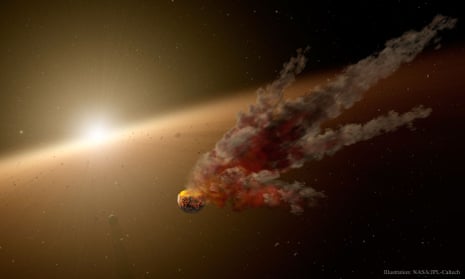You remember the alien megastructure. No? Let me refresh your memory. Back in October 2015, the internet nearly broke when astronomers announced they had detected a strange signal that stood a remote chance of being a vast extraterrestrial construction - dubbed the alien megastructure.
It was discovered using Nasa’s Kepler Space Telescope, which was designed to look for the slight drop in light caused when a planet passes in front of its star. In this case, the telescope gave astronomers much more than they bargained for.
The brightness of star KIC 8462852 dropped by 15% in March 2011 then by 20% in February 2013 then returned to normal. Given that a planet dims the light by a mere 1%, whatever was producing this signal was absolutely huge.
Although astronomers talked a lot about natural explanations, such as a cloud of thousands of comets around the star or a disintegrating planet, nothing truly fitted the bill. So they went on to speculate that the signal could be produced by a vast artificial construction that had been placed in orbit to harvest energy from the star’s light.
Such constructions are known as Dyson spheres, after physicist Freeman Dyson, who published on the possibility of their existence in 1960. He himself credited his inspiration as coming from science fiction writer Olaf Stapeldon’s 1937 science fiction novel Starmaker.
Things got exciting again last month, when astronomer Tabetha Boyajian from Louisiana State University, who headed the analysis of the original signals, announced that the star was dimming again. Releasing a world-wide call for other astronomers to turn their telescopes towards the star, she and colleagues began a vigil.
Instead of a nose-dive in brightness, however, the star dropped just 2.5% and then returned to normal after a few days. Nevertheless, the additional data may be enough for them to work out what is going on, or at least whittle down the possibilities.
Sadly, one of the explanations that is looking ever more unlikely is the megastructure. As it absorbs sunlight (causing the dips), so the structure would naturally warm up and give off excessive infrared radiation. This would make the star brighter than normal at infrared wavelengths – but this has not been seen.
Yet, all is not lost for those hoping to find alien megastructures. In the first of a brace of recent papers, astrophysicist Zaza Osmanov, Free University of Tbilisi, Georgia, has pointed out that it would be better to build such a thing around the decaying cinder of a once giant star, rather than a star itselves.
Known as a pulsar, the dead stellar heart is left behind after a star explodes. It still seethes with energy, beaming radio and X-ray emission into the cosmos. Osmanov proposes that migrating to these places to harvest this energy would be a better bet for extraterrestrials than building a Dyson sphere around a normal star.
This is because pulsars emit their energy in narrow beams that sweep through space like a lighthouse. So the resulting megastructure would only need to be a ring around the star, rather than something designed to encapsulate the whole thing.
Turning this from speculation into a testable hypothesis, in his second paper on the subject he calculates that the Very Large Telescope Interferometer (VLTI) in Chile, and the orbiting Wide-field Infrared Survey Explorer (WISE) could be used to look at nearby pulsars for the infrared signature of megastructures.
Even if there are no such things as aliens and megastructures, such calculations are valid he told me during a Skype conversation, because they have the power to capture our imagination and demonstrate that rational scientific thinking can be applied to even wild ideas.
But just before we rule out the alien megastructure as the answer to the original KIC 8462852 data altogether, it’s worth remembering that the lack of an infrared excess goes against most of the natural explanations as well. Large clouds of comet dust or a disintegrating planet (Death Star test?) should also give off a detectable infrared signal.
As a result, the astronomical smart money is now wondering whether smaller clouds of dust or gas lying along our line of sight to the star, rather than something giant in orbit around it, could provide the answer. But the truth is that at this stage the field remains wide open.
To paraphrase Boyajian from a TED talk on the subject: either this is a natural phenomenon we don’t understand, or it’s an alien construction we don’t understand. Either way, it’s exciting news.
Stuart Clark is the author of The Search for Earth’s Twin (Quercus). He will be delivering the Guardian masterclass on Is there life beyond Earth?.

Comments (…)
Sign in or create your Guardian account to join the discussion